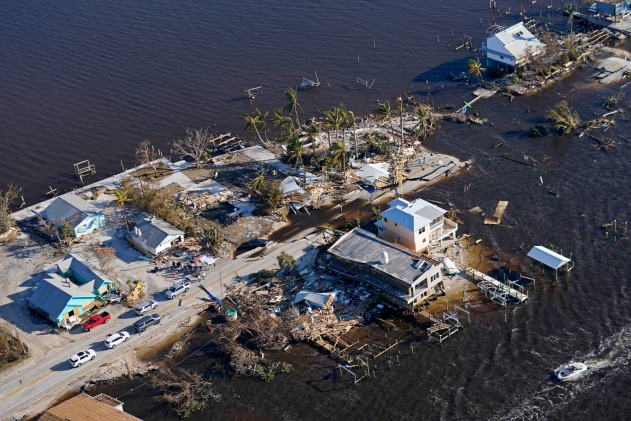
Many Floridians Rebuilding For When The Next Ian Strikes

It’s been an exhausting and grueling three weeks for Florida residents since Hurricane Ian made its catastrophic landfall. Residents are still picking up the pieces and sorting through the damage the storm left behind. While people start to rebuild bridges, homes and communities, one architect is hopeful her words will help inspire smarter and stronger building choices in the wake of Ian.
Joyce Owens, a coastal architect who is designing homes to replace those lost on Sanibel Island — a barrier island in southwestern Florida and one of the hardest-hit areas, told AccuWeather National Reporter Jillian Angeline about her campaign to encourage resiliency in new construction as Sanibel Island recovers. Owen created an educational campaign on social media to encourage people to build back stronger in the months ahead. Her slogan: “Rebuilding. Stronger. Smarter.“
“To build smarter, not just stronger, but smarter,” Owens said. “To build the houses for the future so that they can withstand not only structurally, [but] they can withstand the hurricane forces.”

In an ongoing series on Owen’s Instagram page, she shares information, pictures and tips for all residents who live in the path of or who have been affected by a tropical storm or hurricane, not just those who live on Sanibel Island. The information shared on her page ranges from understanding water damage on different surfaces within the home, what needs to be thrown away and why it’s crucial to have a re-construction permit.
Owens says many of her clients’ homes on Sanibel Island fared well despite Hurricane Ian’s strength and ferocious storm surge.
According to a comprehensive analysis of the damage caused by Ian conducted by the National Weather Service (NWS), Fort Myers Beach was found to have the highest storm surge values of 15 feet above the normal high water level. At this level detected, all of Sanibel Island is believed to have been inundated by feet of water.

“What we see [on Sanibel Island] looks very salvageable,” Owens said.
In videos and photos shared of some of the hardest-hit areas on Sanibel Island, concrete slabs are piled up on the bottom floor of the home, making the damage look worse, but according to Owens, that’s exactly what’s supposed to happen in the homes she designs.
“Our structures are no longer being built of wood pilings or concrete pilings, but we’re actually building with concrete underneath the ground to hold these houses in place better,” she said.
Owens explains that before Hurricane Andrew in 1992, many homes were built on these pilings, which she described as being like a “toothpick.” Instead, coastal architects are putting concrete pilings underground and pouring more concrete around them on top to ensure they remain in place during a hurricane.

The concrete poured on the top level of the underground pillars absorbs the damage from a hurricane, reducing the damage done to the home.
“The idea is that when they’re perpendicular to the beach when the storm surge or wave comes through, the water surges through them,” Owens explained. “You’re not putting stress on the structure of the building, you’re just allowing that water to flow through the buildings.”
When walls are parallel to the beach, that is called “blowout construction.” Waves and storm surge crash on those walls, creating a lot of stress on them and putting the building in greater danger of collapsing.
Another important design feature, she notes, is building perpendicularly to the ocean. This creates less surface area for the storm surge to inundate homes, which means the integrity of the structures won’t be as compromised.
Owens adds that since Hurricane Andrew, building codes on the island and in other coastal communities have “changed tremendously.” Residents in coastal communities, like Sanibel Island, aren’t allowed to build rooms on the ground floor, but Owens said it still happens. When storms with catastrophic storm surges occur, people lose everything on that bottom floor.

“One of our goals is to design the homes, so that they have minimal storage down there and instead of having rooms down there, we made them open down below and then we incorporate that openness into the recreational part of the home,” Owen explains.
Owen notes that the way she builds homes on Sanibel Island isn’t just to protect them from the potentially devastating hurricane but rather the “harsh climate” of the island.
“That’s why when I say ‘stronger, smarter,’ I’m not just talking about hurricanes,” Owens says, explaining that the homes and buildings she constructs account for the intense summertime heat, high humidity and torrential daily summertime rainstorms. “There’s a lot to building on an island and a lot more to be building in southwest Florida.”
For those still assessing the damage to their home, Sheldon Yellen, the CEO of Belfor Property Restoration, told AccuWeather in an interview that all homeowners and business owners should look carefully at their policies and discuss them with agents or licensed contractors before ruling their home a total loss.
“We can rebuild a structure, but it’s dependent on the insurance coverage you have,” Yellen said.
Produced in association with AccuWeather.
The Western Journal has not reviewed this story prior to publication. Therefore, it may not meet our normal editorial standards. It is provided to our readers as a service from The Western Journal.
Truth and Accuracy
We are committed to truth and accuracy in all of our journalism. Read our editorial standards.
Advertise with The Western Journal and reach millions of highly engaged readers, while supporting our work. Advertise Today.










